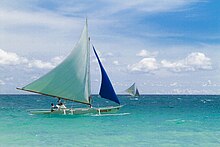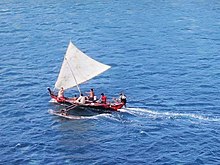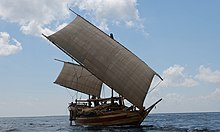Kakap (boat)

Kakap is a narrow river or coastal boat used for fishing in Malaysia, Indonesia, and Brunei.[1][2] They are also sometimes used as auxiliary vessels to larger warships for piracy and coastal raids.[3]
Etymology
The name "kakap" comes from Malay word meaning "spy", "scout", "lookout". Thus, the name means "type of boat used for scouting".[4]
Description
Kakap resemble pangajava but are smaller and lighter. It also uses a mast and rectangular tanja sail. The boards and planks on the hull are not nailed with iron nail, but are attached using a wooden dowel technique and reinforced with rattan bonds. Larger kakap is able to reach eight meters in length and able to carry 10 crews.[5]
The kakap jeram's hull is planked and built with frames, made by meranti (dipterocarp) wood. It has carved figurehead and ornamented sternpost. A washstrake made of bamboo splits sewn together with bamboo withies, and held in position by lashings. A heavy beam is fitted forward and used for winding the anchor cable and bitting it. The steering gear consist of a paddle held on the quarter on a stout upright and held at the neck by a rattan lashing.[6]
It has 1 mast with junk sail. Average length of mast is 13 ft (4 m). The length of a kakap jeram is about 13 ft (4 m), the width is 7 ft (2.1 m), with 3 ft (91 cm) depth. It has a freeboard of 1 ft (30 cm) and crew of 3 men.[7]
Role
In Selangor coast, kakap is used as fishing boat, precisely under the name kakap Jeram. Jeram is the name of big fishing village in the Kuala Selangor district. Its name can be interpreted as "Jeram scouter".[6]
For piracy activities, kakap does not sail alone and often accompanies penjajap and is used as an observer in piracy activities. If merchant ships encountered this boat, a penjajap or lanong must be hiding around the waters. Kakap is also suitable to be used to go along the beach and sail to the river estuary. If attacked, kakap can land easily on the beach or riverbank to make it easier for the crew to escape to the mangrove or palm forest area while carrying the boat with them. Sea people use kakap which can contain 20 people used for piracy activities at sea.[8]
See also
References
- ^ Hussin, Nordin (2007). Trade and Society in the Straits of Melaka: Dutch Melaka and English Penang, 1780-1830. NUS Press. p. 64. ISBN 9789971693541.
- ^ Vogel, Jaap (2016). "J.C. Van Leur, 1908-1942: A Short Life History". In Blussé, Leonard; Gaastra, Femme S. (eds.). On the Eighteenth Century as a Category of Asian History: Van Leur in Retrospect. Routledge. ISBN 9781351913720.
- ^ Warren, J.F. The Sulu Zone, 1768-1898. Singapore: The Singapore University Press.
- ^ Smyth, H. Warington (May 16, 1902). "Boats and Boat Building In the Malay Peninsula". The Journal of the Society of Arts. 50 – via JSTOR.
- ^ Zainun, Nazarudin (2015). Antropologi Dan Sejarah Dalam Kearifan Tempatan. Penerbit USM. ISBN 9789838619325.
- ^ a b Smyth, H. Warrington (1906). Mast and Sail in Europe and Asia. John Murray.
- ^ United States. Office of Strategic Services. Research and Analysis Branch (1944). Native Craft in Southeast Asia Waters. Office of Strategic Services. Research and Analysis Branch.
- ^ Mohamed Zen (2002). Orang Laut: Studi Etnopedagogi. Bandung: Penerbit Yayasan Bahari Nusantara





